

Getting coronavirus from runners, cyclists, or air outside is unlikely. Under social distancing, we’re all doing our best to stay sane, and one of the best ways to maintain sanity is to go out for some nice fresh air.
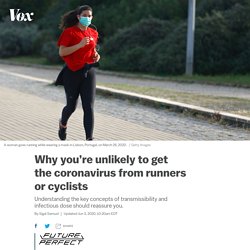
But venturing outside can be stressful if you’re worried that the very air is full of virus particles just waiting to infect you. So, how worried should you be that any time you go outside, you’ll contract coronavirus from a fellow pedestrian, runner, or cyclist who happens to exhale as they pass by? The answer is, you probably don’t need to freak out about it. As long as you’re maintaining at least 6 feet of distance from other people and you’re not in a high-risk group, you’re engaged in a very low-risk activity, particularly if you and others are wearing masks. In April, Belgian and Dutch engineers publicized some findings that went viral online and gave people the opposite impression.
In other words, the “study” failed to consider two key questions: How easy is it for particles traveling in the air outdoors to infect you? Transcript for the CDC Telebriefing Update on COVID-19. Welcome and thank you for standing by.

At this time, all participants are on listen-only mode until our question and answer session. At that time, if you would like to ask a question, please press star then one. Please be advised today’s conference is being recorded. If you have any objections, you may disconnect at this time. Now I would like to turn the meeting over to Mr. Thank you. Thank you for joining us. Brittany, we’re ready to take questions. Thank you. Explainer: How the coronavirus tricks its way into human cells. 'I Tested Positive For Novel Coronavirus. Here's What It's Like' This article has been medically reviewed by Keri Peterson, MD, Internal Medicine, Mount Sinai Hospital.
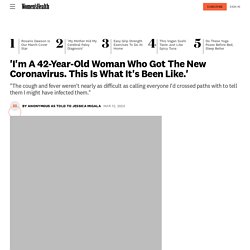
On Friday, March 6, I was sitting in my living room when I got the voicemail message that just said, "Call me back," in an urgent tone. That's when I knew that I had tested positive for the new coronavirus, aka COVID-19. I’m fine now, mostly, a little short of breath with an occasional cough, but it's been...an experience.
Here’s how everything happened: On Tuesday, February 25, I was at a lunch with seven people at a restaurant, which is where I suspect I caught the virus. I later learned that one person was infected, although I didn't notice her showing any symptoms yet. On Friday, February 28, I woke up with a sore throat and headache. I live near Seattle, and the day I got sick, I learned that someone in the area had gotten COVID-19. At that point, the new coronavirus was on my mind. I was really worried, but she told me I didn’t meet the criteria for testing. COVID-19 Superspreader Events in 28 Countries: Critical Patterns and Lessons. In 1899, a German bacteriologist named Carl Flügge proved that microbes can be transmitted ballistically through large droplets that emit at high velocity from the mouth and nose.
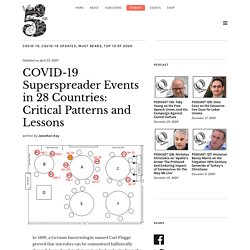
His method for proving the existence of these “Flügge droplets” (as they came to be known) was to painstakingly count the microbe colonies growing on culture plates hit with the expelled secretions of infected lab subjects. It couldn’t have been pleasant work. Covid-19 Symptoms (Coronavirus): What to Do If You Might Have It. Coronavirus Disease (COVID-19) and Breastfeeding. Baby boy infected with coronavirus in womb. Doctors in France have reported what they believe to be the first proven case of Covid-19 being passed on from a pregnant woman to her baby in the womb.
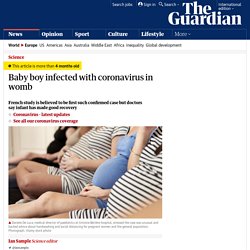
The newborn boy developed inflammation in the brain within days of being born, a condition brought on after the virus crossed the placenta and established an infection prior to birth. He has since made a good recovery. The case study, published in Nature Communications, follows the birth of a number of babies with Covid-19 who doctors suspect contracted the virus in the womb. Until now, they have not been able to rule out the possibility that the babies were infected during or soon after delivery. “Unfortunately there is no doubt about the transmission in this case,” said Daniele De Luca, medical director of paediatrics and neonatal critical care at the Antoine Béclère hospital in Paris. Tests on the baby’s blood and fluid extracted from the lungs revealed Covid-19 infection but ruled out other viral, bacterial and fungal infections.
Placenta lacks major molecules used by SARS-CoV-2 virus to cause infection. Loading Skip to main content Site Menu.
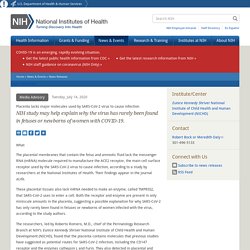
Coronavirus Hub: Cell Press. Understanding COVID-19: A Primer. As a psychologist, I am not well-versed in the technical language of viruses.

As such, I took some time to ask my friend, Dr. Waldemar Schmidt, who is an MD/Ph.D. pathologist some questions about the virus. 1. What is the size of the coronavirus? Robert Eliot’s aphorism applies to our current pandemic: Rule No. 1: Don't sweat the small stuff. COVID-19 (Novel Coronavirus) Covid-19. Cases of Covid-19 first emerged in late 2019, when a mysterious illness was reported in Wuhan, China.
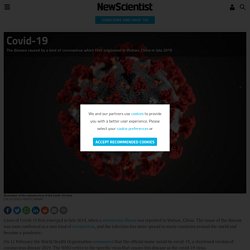
The cause of the disease was soon confirmed as a new kind of coronavirus, and the infection has since spread to many countries around the world and become a pandemic. On 11 February the World Health Organization announced that the official name would be covid-19, a shortened version of coronavirus disease 2019. The WHO refers to the specific virus that causes this disease as the covid-19 virus. This is not the formal name for the virus – the International Committee on Taxonomy of Viruses calls it the “severe acute respiratory syndrome coronavirus 2”, or SARS-CoV-2, because it is related to the virus that caused the SARS outbreak in 2003. Remaining calm in adversity: What Stoicism can teach us during the coronavirus pandemic. People around the world are feeling rudderless and adrift.
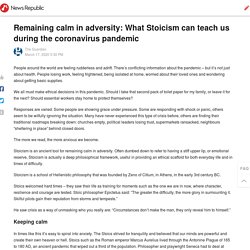
There’s conflicting information about the pandemic – but it’s not just about health. People losing work, feeling frightened, being isolated at home, worried about their loved ones and wondering about getting basic supplies. We all must make ethical decisions in this pandemic. Should I take that second pack of toilet paper for my family, or leave it for the next? Here's Why The Coronavirus Mortality Rate Is Different From Place To Place. If you’re standing in Germany, the coronavirus pandemic might look a little bit less overwhelming than if you’re standing in, say, Italy or the United States.
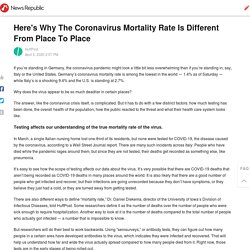
Germany’s coronavirus mortality rate is among the lowest in the world ― 1.4% as of Saturday ― while Italy’s is a shocking 9.4% and the U.S. is standing at 2.7%. Why does the virus appear to be so much deadlier in certain places? The answer, like the coronavirus crisis itself, is complicated. But it has to do with a few distinct factors: how much testing has been done, the overall health of the population, how the public reacted to the threat and what their health care system looks like. Testing affects our understanding of the true mortality rate of the virus.
A study on infectivity of asymptomatic SARS-CoV-2 carriers. SCIENCEMAG 19/05/20 Why do some COVID-19 patients infect many others, whereas most don’t spread the virus at all? Science’s COVID-19 reporting is supported by the Pulitzer Center. When 61 people met for a choir practice in a church in Mount Vernon, Washington, on 10 March, everything seemed normal.
For 2.5 hours the chorists sang, snacked on cookies and oranges, and sang some more. Expert reaction to questions about COVID-19 and viral load. March 24, 2020 There have been questions from journalists about viral load ad the COVID-19 outbreak. Comments sent out on Thursday 26 March 2020. Immunity conferred by covid-19 - Recherche Google. Testing for Antibodies to SARS-CoV-2: Timing Important for Accuracy. Serology tests were better at detecting the presence of antibodies to the severe acute respiratory syndrome coronavirus 2 (SARS-CoV-2) in patients when they were tested 15 to 35 days post-symptom onset, according to the findings of a recently published review on the Cochrane Database of Systematic Reviews. The review aimed to evaluate the diagnostic accuracy of antibody tests at detecting current or previous SARS-CoV-2 infection, as well as the potential use of these tests in seroprevalence surveys.
An electronic search of the Cochrane COVID-19 Study Register and the COVID-19 Living Evidence Database from the University of Bern yielded 54 relevant studies, 38 of which were analyzed in detail. Findings of the study revealed that the sensitivity of antibody tests were low 1 week after symptom onset, but increased in the second and third week. In their review, the authors also highlighted their concerns surrounding the risk of bias present in the studies included in their analysis. BMJ 25.06 Ac Testing and timing. Consistent Detection of 2019 Novel Coronavirus in Saliva. We use cookies to enhance your experience on our website.By continuing to use our website, you are agreeing to our use of cookies. You can change your cookie settings at any time. <a href=" Find out more</a> Skip to Main Content Search. Coronavirus Disease 2019 (COVID-19) NOT-MH-19-033: Notice of Data Sharing Policy for the National Institute of Mental Health. Notice of Data Sharing Policy for the National Institute of Mental Health Notice Number: NOT-MH-19-033 Key DatesRelease Date: June 17, 2019.
Coronavirus COVID-19 (2019-nCoV) Data sources: WHO, CDC, ECDC, NHC and DXY and local media reports. Read more in this blog. Contact US. FAQ. Coronavirus COVID-19 (2019-nCoV) statistics. Lancet Inf Dis Article: Here. Mobile Version: Here. Data sources: Full list. COVID-19 tracker. Coronavirus Disease (COVID-19) – Statistics and Research. COVID-19 Resources.
The COVID-19 crisis. Intervention.ally. Take Sambucol-Coronovirus Self-Assistance – Part 1. Published on March 21, 2020 Written by Geraint Hughes As a good starting point, I would suggest Sambucol. This alternative health food product has been around for decades and is available in extract, liquid, tab and pill forms and has been used as an old folk remedy in Europe and Africa going back centuries. It is an extract of Elderberry and its quite drinkable. Many studies have been conducted on it and found it to be beneficial against many different types of flu viruses, none have been conducted on Coronavirus of course, but seeing as Coronavirus is a flu type virus, it seems perfectly reasonable that a cheap, easily available product which assists against one type may also be of benefit against another type.
What is Sambucol? If the link is to believed, and I have no valid reason to doubt it, it helps against the flu. Let’s look at some specific research as well. “Elderberry compounds could help minimize flu symptoms, study suggests” This is what they concluded. MPR 22.07 Ibuprofeno y COVID.
Myriad Symptoms. COVID-19 Conglomerates. ... en vue. COVID-19 Basics. Notice: Users may be experiencing issues with displaying some pages on stanfordhealthcare.org. We are working closely with our technical teams to resolve the issue as quickly as possible. Thank you for your patience. Health Care Professionals During this difficult time, we are all experiencing stress in some form. OverTime. SARS-COV-2. Coronaviruses. Viral Health. Test Test Goose. July 2020. Pandemic Problems.
Robust. Coronavirus. Research and science behind COVID-19. Covid 19 Pathogen. MEDICAL.